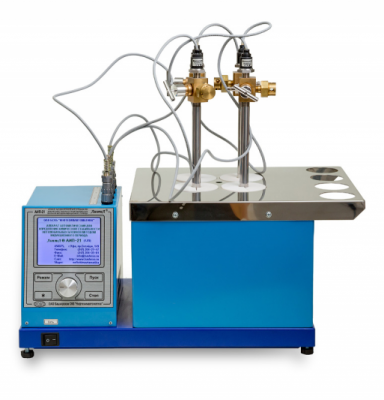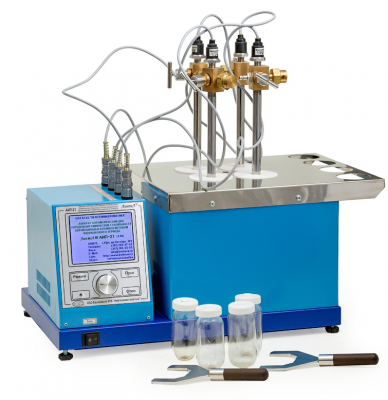Lintel AIP-21 Automatic device
The Lintel AIP-21 automatic device is used to determine the chemical stability of gasoline using the induction period method, which performs the testing process fully automatically.
The Lintel AIP-21 Gasoline Chemical Stability Tester performs the test process fully automatically. It maintains the thermostat temperature without generating excess heat, checks the tightness of the bombs, counts the test time, determines the induction period, and stores the test results.
- The Lintel AIP-21 device provides full automation of the testing process – maintaining the thermostat temperature without overheating, checking the tightness of the bombs, counting the test time, determining the induction period and storing the test results.
- The thermostatic bath contains four cells for installing bombs, which allows testing up to 4 product samples simultaneously.
- The device uses a dry-block thermostat, which ensures high heating speed and reaching the required temperature, and also eliminates the need to use a coolant and monitor its condition.
- The device uses a bomb with a safety valve, when the safety valve is triggered, the gas pressure decreases slowly, the outgoing flow is not dangerous, this ensures the safety of personnel. The safety valve is set to operate at 1530±150 kPa at the manufacturer. After the valve is triggered, it is restored to its original closed position by itself and there is no need to replace the valve after the valve is triggered.
- Integration with the Lintel Link data collection system allows for collection and transmission of laboratory test results from the device to a personal computer via wireless communication. Integration with the Lintel LIS laboratory information system provides comprehensive automation of laboratory activities.
- To check the readings of the device during certification, calibration of the built-in thermostat temperature sensor, and pressure sensors in the bombs, it is possible to connect a reference pressure gauge and install a reference thermometer.
- The full self-diagnostic system with indication of the causes of malfunctions on the display allows to automatically detect oxygen leaks from bombs, prevent overheating of the system. If the operator’s intervention is necessary, the display shows a corresponding message and a periodic sound signal is given
- The device uses a high-contrast color TFT display, which made it possible to implement an intuitive user interface with the display of all necessary information during testing and viewing the results, including graphs of pressure changes in the bombs.
- Monitoring the test process and generating a graph of the heating pressure drop in real time on a color display
- Automatic test stop with sound signal indicating test completion
- The device provides storage in non-volatile memory of up to 300 test results and graphs of pressure changes in bombs
| Number of bombs tested simultaneously | pcs from 1 to 4 |
|---|---|
| Atmospheric pressure | kPa from 90.6 to 106.6 |
| Thermostat temperature | °C 100 |
| Thermostat temperature maintenance error | °C ±1 |
| Limit of permissible error in measuring pressure in a bomb | kPa ±20 |
| Power consumption in test mode | Tue 3500 W |
| Dimensions without packaging | WxHxD 530x290x330 mm |
| Dimensions with packaging | WxHxD 840x660x560 mm |
| Weight without packaging | 25 kg |
| Gross weight | 50 kg |
| Ambient temperature | from 10 to 35°C |
| Relative humidity at a temperature of +25°C | 80% |
| Power supply voltage | from 187 to 253 V |
| Power supply frequency | from 49 to 51 Hz |
| Service life | 6 years, with no more than 15,000 hours of operation |
| Electrical safety | Grounding of non-current-carrying parts and compliance with protection class 0I according to GOST R IEC 61140-2000 |
| Sound accompaniment | Sound signal at the end of the test, detection of a fault |
| Diagnostics and setup | Built-in self-diagnostics and configuration algorithms, notifying users about the causes of malfunctions |
| brand | |
| Standards |
هیچ ویدیویی برای این محصول موجود نیست.





